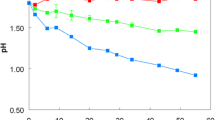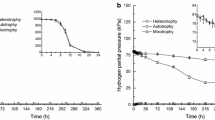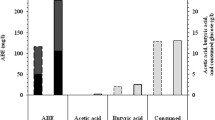Abstract
A Synthrophomonas wolfei-Methanospirillum hungatei coculture was adapted to catabolize crotonate. S. wolfei was then isolated in axenic culture using agar spread plates and roll tubes with crotonate as the sole energy source. S. wolfei catabolized crotonate via a disproportionation mechanism similar to that of some Clostridium species. Growth on crotonate was very slow (specific growth rate of 0.029 h−1) but the conversion of energy into cell material was very efficient with cell yields of 14.6 g (dry wt.) per mol of crotonate. S. wolfei alone did not catabolize butyrate, but butyrate was stoichiometrically degraded to acetate and presumably methane when S. wolfei was reassociated with M. hungatei. S. wolfei-M. hungatei cocultures accumulated some butyrate during growth on crotonate indicating that protons were not the sole electron acceptors used for crotonate oxidation by the coculture.
Similar content being viewed by others
References
Bader J, Gunther H, Scheicher E, Simon H, Pohl S, Mannheim W (1980) Utilization of (E)-2-butenoate (crotonate) by Clostridium kluyveri and some other Clostridium species. Arch Microbiol 125:159–165
Balba MT, Nedwell DB (1982) Microbial metabolism of acetate, propionate, and butyrate in anoxic sediments from the Colne Point Salt Marsh, Essex, UK. J Gen Microbiol 128:1415–1422
Balch WE, Wolfe RS (1976) New approach to the cultivation of methanogenic bacteria: 2-mercaptoethanesulfonic acid (HSCoM)-dependent growth of Methanobacterium ruminantium in a pressurized atmosphere. Appl Environ Microbiol 32:781–791
Baresi L, Mah RA, Ward DM, Kaplan IR (1978) Methanogenesis from acetate: enrichment studies. Appl Environ Microbiol 36:186–197
Beaty PS, McInerney MJ, Wofford NQ (1986) Energetics of H2-producing syntrophic bacteria. In: Antonopoulos AA (ed) Biotechnological advances in processing municipal wastes for fuels and chemicals. Argonne National Laboratory, Argonne, Illinois, pp 67–83
Boone DR (1982) Terminal reactions in the anaerobic digestion of animal wastes. Appl Environ Microbiol 43:57–64
Boone DR, Bryant MP (1980) Propionate-degrading bacterium, Syntrophobacter wolinii sp. nov. gen. nov., from methanogenic ecosystems. Appl Environ Microbiol 40:626–632
Bryant MP (1972) Commentary on the Hungate technique for culture of anaerobic bacteria. Am J Clin Nutr 25:1324–1328
Bryant MP (1976) The microbiology of anaerobic digestion and methanogenesis with special reference to sewage. In: Schlegel HG, Barnes J (eds) Microbial energy conversion. Goltze, Göttingen, pp 107–118
Bryant MP, Wolin EA, Wolin MJ, Wolfe RS (1967) Methanobacillus omelianskii, a symbiotic association of two species of bacteria. Arch Microbiol 59:20–31
Eichler B, Schink B (1985) Fermentation of primary alcohols and diols in pure culture of syntrophically alcohol-oxidizing anaerobes. Arch Microbiol 143:60–66
Henson JM, Smith PH (1985) Isolation of a butyrate-utilizing bacterium in coculture with Methanobacterium thermoautotrophicum from a thermophilic digestor. Appl Environ Microbiol 49:1461–1466
Jenneman GE, McInerney MJ, Knapp RM (1986) Effect of nitrate on biogenic sulfide production. Appl Environ Microbiol 51:1205–1211
Kasper HF, Wuhrmann K (1978) Kinetic parameters and relative turnovers of some important catabolic reactions in digesting sludge. Appl Environ Microbiol 36:1–7
Mah RA (1982) Methanogenesis and methanogenic partnerships. Phil Trans R Soc Lond B 297:599–616
McCarty PL, Jeris JS, Murdoch W (1963) Individual volatile fatty acids in anaerobic treatment. J Water Pollution Control Fed 35:1501–1516
McInerney MJ, Bryant MP (1980) Metabolic stages and energetics of microbial anaerobic digestion. In: Stafford DA, Wheatley BI, Hughes DE (eds) Anaerobic digestion 1980. Appl, London, pp 91–98
McInerney MJ, Bryant MP, Hespell RB, Costerton JW (1981) Syntrophomonas wolfei gen. nov., sp. nov., an anaerobic, syntrophic, fatty acid-oxidizing bacterium. Appl Environ Microbiol 41:1029–1039
McInerney MJ, Bryant MP, Pfennig N (1979) Anaerobic bacterium that degrades fatty acids in syntrophic association with methanogenes. Arch Microbiol 122:129–135
Mountfort DO, Bryant MP (1982) Isolation and characterization of an anaerobic synthrophic benzoate-degrading bacterium from sewage sludge. Arch Microbiol 133:249–256
Sharak-Genthner BR, Davis CL, Bryant MP (1981) Features of rumen and sludge strains of Eubacterium linosum, a methanoland H2-CO2-utilizing species. Appl Environ Microbiol 42:12–19
Schink B (1985) Mechanisms and kinetics of succinate and propionate degradation in anoxic freshwater sediments and sewage sludge. J Gen Microbiol 131:643–650
Shelton DR, Tiedje TM (1984) Isolation and partial chracterization of bacteria in an anaerobic consortium that mineralizes 3-chlorobenzoic acid. Appl Environ Microbiol 48:840–848
Stieb M, Schink B (1984) A new 3-hydroxybutyrate fermenting anaerobe, llyobacter polytropus, gen. nov. sp. nov., possessing various fermentation pathways. Arch Microbiol 140:139–146
Stieb M, Schink B (1985) Anaerobic oxidation of fatty acids by Clostridium bryantii sp. nov., a spore-forming, obligately syntrophic bacterium. Arch Microbiol 140:387–390
Thauer RK, Jungermann K, Henninger H, Wenning H, Decker K (1968) The energy metabolism of Clostridium kluyveri. Eur J Biochem 4:173–180
Thauer RK, Morris JG (1984) Metabolism of chemotrophic anaerobes: old view and new aspects. Symp Soc Gen Microbiol 36:123–168
Wofford NQ, Beaty PS, McInerney MJ (1986) Preparation of cell-free extracts and the enzymes involved in fatty acid metabolism in Syntrophomonas wolfei. J Bacteriol 167:179–185
Zinder SH, Koch M (1984) Non-aceticlastic methanogenesis from acetate: acetate oxidation by a thermophilic syntrophic coculture. Arch Microbiol 138:263–272
Author information
Authors and Affiliations
Rights and permissions
About this article
Cite this article
Beaty, P.S., McInerney, M.J. Growth of Syntrophomonas wolfei in pure culture on crotonate. Arch. Microbiol. 147, 389–393 (1987). https://doi.org/10.1007/BF00406138
Received:
Accepted:
Issue Date:
DOI: https://doi.org/10.1007/BF00406138




